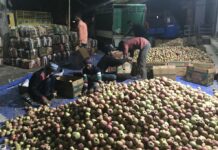All banks have a basket enabling them to infuse micro credit in key sectors. But most of these schemes partnered by the governments are not an impressive success and may require relook and repackaging, given the surging jobless in the state, reports Tasavur Mushtaq
Haleema, 33, is a household name in Srinagar’s crowded Qamarwari belt. Widowed at the age of 27 and mother of two, she is a model entrepreneur. She makes electric coils for heaters and boilers.
Six years ago, she was in doldrums. Tragedies visited her in quick succession. First, her bus conductor husband died in a road accident. Then, her in-laws showed her door with two daughters in the lap. A childhood orphan herself, she was unwilling to stay with her brother. Eventually somebody guided her to J&K Bank suggesting she should avail J&K Self Employment Scheme. She applied and got Rs 1.50 lakh and then decided how to use this properly. She started making coils and now her product is a preferred one. She managed a dignified life for her two daughters.
Thousands of men and women have availed JKSES and other schemes which government sponsors. Many people have seen their takeoff in business while modestly starting with these funds.
Under five major schemes – National Rural Livelihood Mission (NRLM), Prime Minister’s Employment Generation Programme (PMEGP), National Urban Livelihood Mission (NULM), J&K Self Employment Scheme (JKSES) and SC/ST/OBC, banking sector in the state in the fiscal 2014-15 has disbursed Rs 209.78 crore to 9028 individuals across the state. Target for the entire year, however, was to cover 24230 individuals and give them Rs 445.18 crore. But barely less than half of the targets were achieved.
JKSES in the state is put on hold for the time being.
The performance in last fiscal has led to reducing the target by almost half for the current fiscal – from Rs 445.18 crore in 2014-15 to only Rs 195.24 crore for 2015-16. By the end of the first quarter – the achievement is only nine percent. They have dispensed only Rs 17.42 crores across J&K to 720 individuals.
Under priority sector lending, government has devised various instruments that help infuse credit in the handicrafts and handloom sectors forming base of the craft economy. But even it has been working up to the mark.
In case of handicrafts, for instance, against a target of Rs 263.35 crore for 25561 beneficiaries, only Rs 12.12 crore to 1335 beneficiaries were covered by June 30, 2015, indicating achievement of 5 per cent. J&K Bank in this sector contributes 70 percent of total credit exposure.
Similarly in handlooms (micro credit plan), against target of Rs 28.51 crore for 2834 beneficiaries, only Rs 2.40 crore to 301 beneficiaries was disbursed registering achievement of achievement of 8 percent in financial terms and 11 percent in physical terms. J&K Bank, again, contributes 75 percent of total disbursement.
Under Artisan Credit Card, term loan facility of Rs 90000 is sanctioned in two installments. Those who have availed said the procedure to avail the facility is ‘hectic’ and quantum of finance is too small to match the present day market demands.
Almost all other schemes meet the same fate.
Bankers when asked about the poor state of implementation flagged many issues that come in between identification, sanction and disbursement. “The second process starts with the recovery and we have bad patches,” one executive of a PSU bank said. “We have even written off some default to keep our slate clean.”
The date that was shared, perhaps for the first time by the state level bankers committee this summer, does not corroborate the default claim (see table). In fact JKSES has functioned smoothly, so is PMEGP and NRLM. To an extent the scheme for backward classes is not performing badly. The only issue seemingly is with the NULM but it is comparatively a newer scheme.
Table: Default In Sponsored Schemes So far
| Scheme | Outstanding (Rs Cr) | Gross NPA (Rs Cr) | %age |
| NRLM | 92.05 | 7.21 | 7.83 |
| PMEGP | 175.84 | 13.68 | 7.78 |
| JKSES | 220.16 | 14.33 | 6.51 |
| NULM | 26.85 | 6.31 | 23.50 |
| SC/ST/OBC | 55.48 | 7.19 | 12.96 |
But the problems lie elsewhere. For instance, all these schemes are linked to the subsidies that the government has to release. In certain schemes, it comes in installments. It has also happened that while the first installment came in time, the subsequent never came or came too late.
In fact the delay in the identification and processing of these schemes from two ends – the banks and the line-government departments, take a long time in processing the papers. “I know a few cases in which it took years and by that time the individuals were in deft,” a banker said. “By the time the case was approved, and money released, the first part went in his personal debt servicing – the project never took off.”
In many cases the loans availed was misused. “There is diversion of funds and this results in failing the concept for which these schemes were introduced,” another bank executive lamented.
Even in a section of the government, there is a new thinking process: the sponsored schemes have lost relevance because they have small ticket size. All these issues require a relook at this basket and the banks must take it right on priority.
















